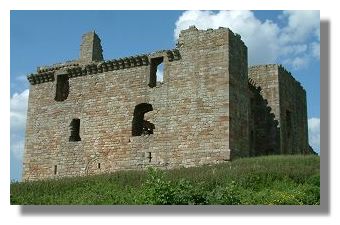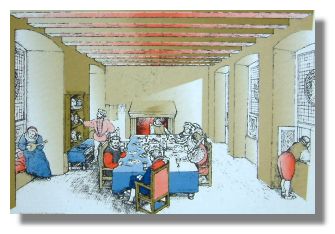
Places to Visit in Scotland
- Crichton Castle, Lothian

A 600-Year-Old Tower HouseSet in a wild moorland at the end of a track, off a minor road in Midlothian, Crichton is not the easiest of castles to reach, even though it is only a short drive from Edinburgh. But its bleak location and approach by a rutted track, makes it easier to imagine what it would have been like in days gone by.
The Crichton family had an estate here from at least as early as the 13th century. John de Crichton was granted a charter for the barony from King Robert III (who reigned from 1390 to 1406). It may have been this John de Crichton who first constructed a great tower house, the remains of which can still be seen today.
John's son William was a trusted servant of King James I. He became Sheriff of Edinburgh and keeper of Edinburgh Castle and Chancellor of Scotland during the minority of James II who came to the throne in 1437.

William Crichton spent much of his life quarrelling with the powerful Black Douglas family. Crichton was responsible for the famous "Black Dinner" in Edinburgh Castle at which the Sixth Earl of Douglas and his brother were murdered. William became Lord Crichton in 1447 and in 1452, when he was keeper of Stirling Castle, the 8th Earl Douglas was killed in this royal castle - this time by King James II himself!William was a wealthy man (he even lent money to the king - which may explain part of his influence) and greatly extended his father's castle. Much of the building and its defences which we see today were created by him.
Following William's death, however, the power of the Crichton's shrunk rapidly. His son died not long after his father. His heir, the third Lord Crichton, was embroiled in an affair with the sister of King James III which resulted in a child. Then he was implicated in a conspiracy involving the king's younger brother. This led to the forfeiture of his estates and title.
Bothwells Take Over
King James IV (1488-1513) granted the castle and estate to Sir Patrick Hepburn, the 2nd Lord Hailes. Hepburn was also given the lordships of Bothwell beside the river Clyde and Crichton was elevated to a new Earldom of Bothwell.
With such extensive properties, the Hepburns spent little time at Crichton Castle. But in 1559, the 4th Earl intercepted a sum of 4,000 crowns sent by Queen Elizabeth I of England to assist the Protestant cause. This resulted in the castle being besieged and captured.
Two years later, Lord John Stewart, a half-brother of Mary Queen of Scots, married the 4th Earl's sister in Crichton Castle and the queen herself attended.
In April, 1567, James Hepburn, 4th Earl of Bothwell, seized and carried off Mary Queen of Scots to Dunbar, and on 15 May, after he had divorced his own wife, they were married at Holyrood. The Scottish nobles were scandalised and rose in revolt. When the rival armies met at Carberry Hill, Bothwell's forces dispersed without a struggle and the queen became a prisoner in Loch Leven Castle. Bothwell escaped to Shetland, and thence to Norway. He was captured there and spent the next ten years in prison. Understandably, he lost his mind before his death on April 14, 1578.
Unique Stonework
In 1581 a kinsman of the Earl of Bothwell inherited Crichton Castle and became the 5th Earl of Bothwell. He was a highly educated and cultured man who had spent a great deal of time on the continent of Europe. He could converse on three foreign languages and had boundless energy - which often resulted in him becoming involved in brawls.The fifth Earl of Bothwell was responsible for extending and embellishing the castle, incorporating features he had seen during his continental travels. He was responsible for the arcade of diamond-faceted stonework (pictured here), which is unique in Scotland.
In 1586 he entertained King James VI at Crichton and no doubt impressed the monarch with his culture and his building works. But the fifth Earl's aggression got him into trouble once too often and by 1595 he had fled to Europe again. The King ordered Crichton Castle to be razed to the ground - but fortunately his orders were never implemented.
Like many abandoned buildings, stonework began to find its way into other newer constructions. In the 19th century Sir Walter Scott commented on the ruinous state of the castle and included Crichton in his novel "Marmion". This led to the ruins being looked after more carefully and in 1926 it was taken into the care of the government agency Historic Scotland.
How to Find Crichton Castle
The castle is now administered by Historic Scotland and is open Monday to Saturday from 9.30am to 6.30pm during April to September (2pm-6.30pm on Sunday). During October to March there are restricted opening hours. Access to the castle from the car park is via a rough track.From Edinburgh, head for the A68 main road to Galashiels and look for the signs pointing to a road on the right in the village of Crichton.
For a detailed location map, see this StreetMap UK map of the area. (Note that you can access a larger scale map of the area via that Web page).
Return to the Main Index of Places to Visit
Where else would you like to go in Scotland?

